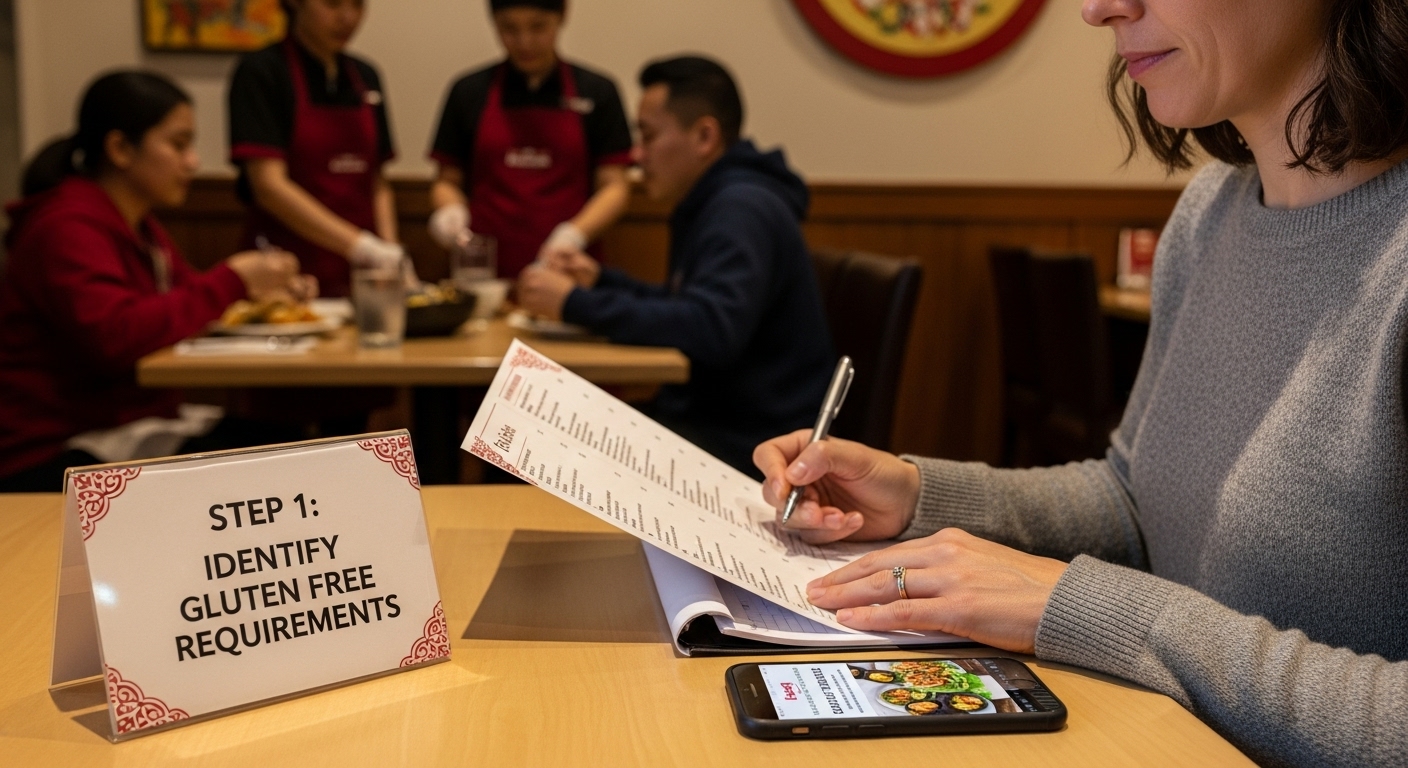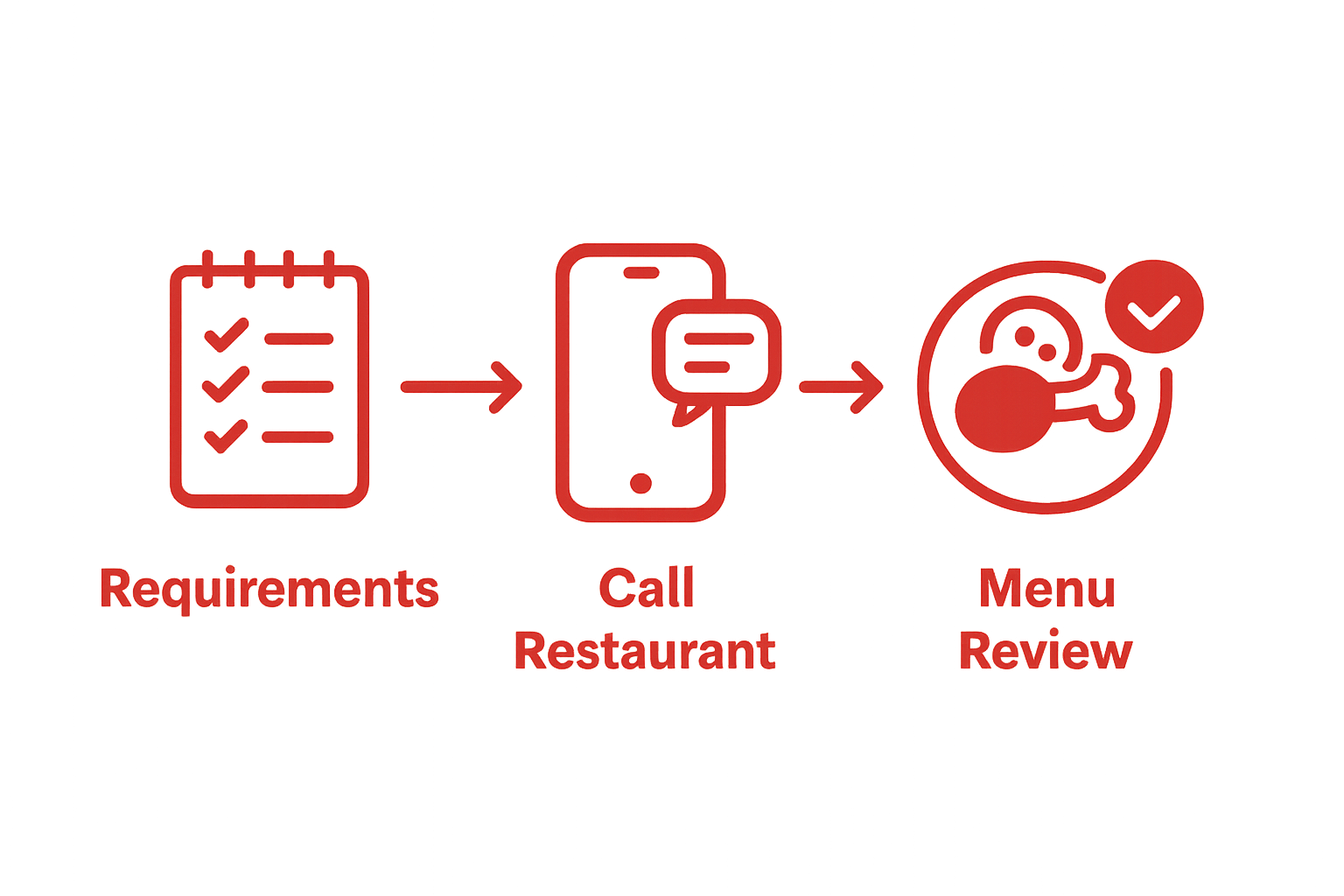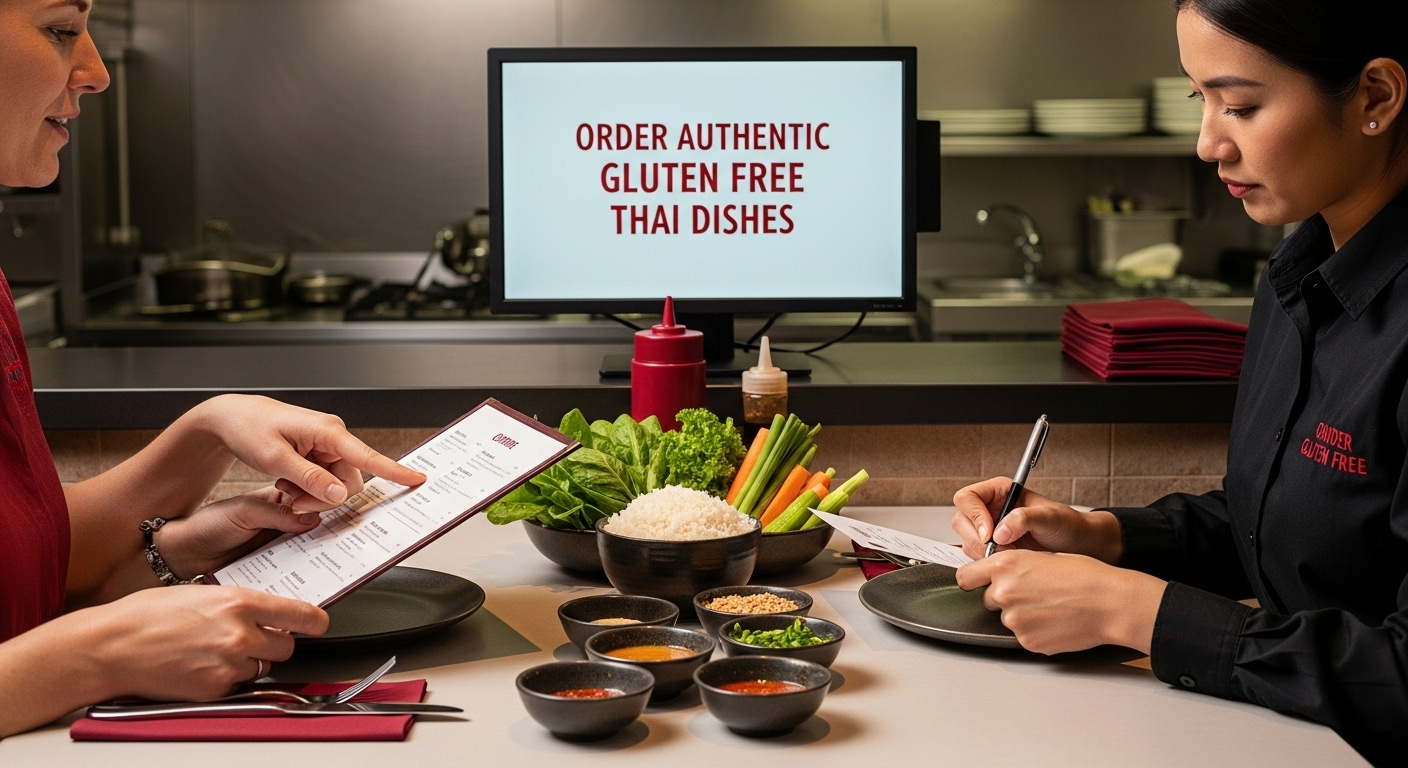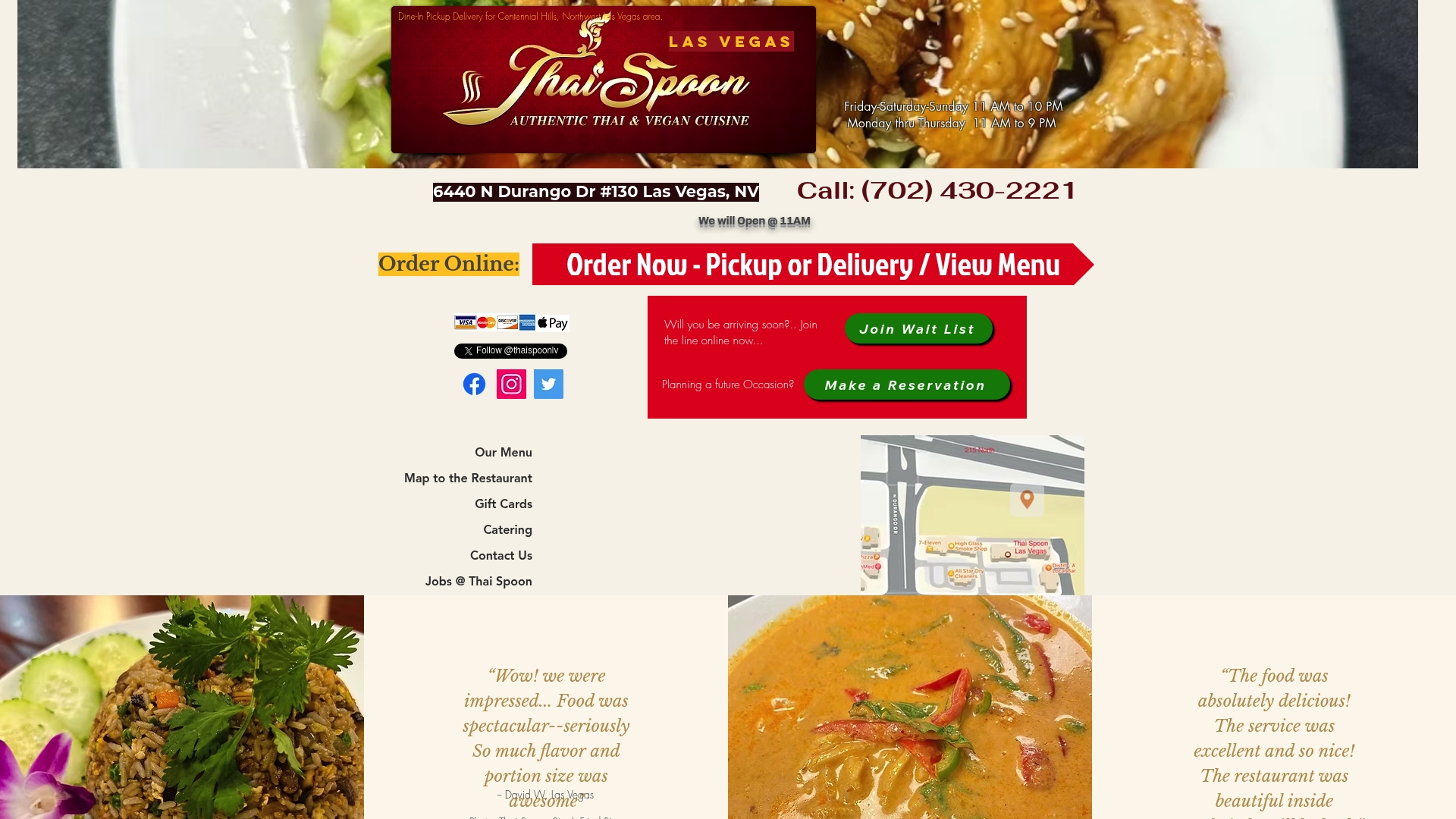How to Choose Gluten Free Thai: A Local's Guide
- mail469793
- Sep 29
- 10 min read

Finding gluten free Thai food can feel overwhelming for anyone who needs clear dietary boundaries. Only about 1% of the US population has celiac disease, but millions more wrestle with sensitivities that make every restaurant choice a big decision. Most people expect Thai cuisine to be a safe haven, bursting with fresh rice and vibrant vegetables. Yet hidden sources of gluten can catch even the most careful diners off guard. The real surprise is that with a methodical approach and the right tools, you can turn even the trickiest menu into a safe and flavorful experience.
Table of Contents
Quick Summary
Key Point | Explanation |
1. Identify personal gluten free needs | Conduct a self-assessment to determine gluten sensitivity levels and dietary restrictions, consulting a healthcare provider if needed. |
2. Research and verify local restaurants | Use online reviews and direct communication to find restaurants that accommodate gluten free diets effectively and transparently. |
3. Review menus meticulously | Carefully examine menus for gluten free options, and clarify suspicion about specific ingredients directly with restaurant staff. |
4. Confirm details with restaurant staff | Ask detailed questions regarding ingredient sourcing and cross-contamination to ensure safe meal preparation. |
5. Provide constructive feedback | Share your dining experience online and directly with restaurant management to help improve gluten free options and support community awareness. |
Step 1: Identify Gluten Free Requirements
Understanding your personal gluten free requirements is the critical first step in navigating Thai cuisine safely and deliciously. Gluten sensitivity varies dramatically between individuals, ranging from mild intolerance to severe celiac disease, which means your approach must be personalized and precise. Before exploring menu options, you need to clearly define your specific dietary restrictions and health needs.
The first task involves conducting a comprehensive self-assessment of your gluten tolerance. This means understanding whether you have a diagnosed medical condition like celiac disease, a wheat allergy, or a more general gluten sensitivity. Medical documentation or professional guidance is crucial in determining the extent of your dietary restrictions. Some individuals require complete gluten elimination, while others might tolerate trace amounts. Consulting with a registered dietitian or your healthcare provider can provide scientifically backed insights into your specific requirements.
Once you have a clear understanding of your personal gluten restrictions, you’ll want to develop a systematic approach to restaurant selection. This involves researching restaurants like Thai Spoon Las Vegas that understand and accommodate gluten free needs. Key verification points include checking if the restaurant has dedicated gluten free preparation areas, staff training on cross-contamination prevention, and transparent ingredient sourcing.
Key criteria for identifying your gluten free requirements include:
Severity of your gluten sensitivity
Specific medical diagnosis
Tolerance level for potential cross-contamination
Willingness to ask detailed questions about food preparation
Successful completion of this step means you have a clear, documented understanding of your personal gluten free needs, empowering you to make informed dining choices in Thai restaurants.
Below is a checklist table to help you verify your gluten free requirements before choosing a Thai restaurant.
Requirement | Purpose | How to Confirm |
Severity of gluten sensitivity | Determines risk profile | Medical diagnosis or history |
Specific medical diagnosis | Guides strictness of diet | Consult healthcare provider |
Tolerance for cross-contamination | Influences restaurant choice | Self-assessment or tests |
Willingness to ask about preparation | Ensures menu safety | Prepare questions for staff |
Documentation of restrictions | Communicates needs clearly | Written or digital records |
This foundational knowledge will guide every subsequent decision in your gluten free culinary journey. |
Step 2: Research Local Thai Restaurants
Researching local Thai restaurants requires a strategic approach that goes beyond simple online searching. Your goal in this step is to identify restaurants that not only serve delicious Thai cuisine but also understand and accommodate gluten free dietary needs comprehensively. This process demands careful investigation and multiple verification methods to ensure a safe and satisfying dining experience.
Start by leveraging digital platforms that provide detailed restaurant information. Websites and apps like Yelp, Google Reviews, and specialized gluten free dining directories can offer valuable insights into restaurant practices. Look specifically for reviews mentioning gluten free options and cross-contamination prevention. Pay close attention to comments from diners with similar dietary restrictions, as their experiences can reveal nuanced details about a restaurant’s approach to gluten free preparation.
Discover how to find authentic local Thai food by expanding your research beyond digital platforms. Contact restaurants directly to discuss their gluten free protocols. A thorough phone conversation can reveal more information than online reviews. Ask specific questions about ingredient sourcing, kitchen preparation methods, and staff training on gluten free food handling. Restaurants committed to dietary accommodations will typically be transparent and detailed in their responses.
Key research strategies include:
Checking online reviews with specific gluten free mentions
Calling restaurants directly to discuss dietary accommodations
Reviewing online menus for clearly marked gluten free options
Examining restaurant websites for dedicated gluten free information
Successful completion of this research step means you have a curated list of Thai restaurants that demonstrate a genuine understanding of gluten free requirements. Your investigation transforms potential dining risks into informed, confident choices that prioritize both your health and culinary enjoyment.

Step 3: Check Menus for Gluten Free Options
Examining restaurant menus for gluten free options requires a methodical and vigilant approach that goes beyond simply scanning for labeled dishes. Thai cuisine presents unique challenges due to ingredients like soy sauce, wheat-based noodles, and potential hidden gluten sources that might not be immediately apparent. Your goal is to develop a comprehensive strategy for menu navigation that protects your dietary needs while ensuring a satisfying culinary experience.
Digital menu exploration becomes your primary investigative tool. Modern restaurants often provide online menus that can be carefully scrutinized before you arrive. Learn more about gluten-free Thai cuisine fundamentals to understand the potential pitfalls. Look for explicit gluten free designations, but do not rely solely on these markers. Ingredients like traditional fish sauce, curry pastes, and certain marinades frequently contain gluten, requiring deeper investigation. When reviewing online or physical menus, focus on dishes that naturally avoid wheat products such as rice-based meals, stir-fries without soy sauce, and protein-focused entrees.
Engaging directly with restaurant staff becomes crucial in this process. A comprehensive menu review involves calling the restaurant to discuss specific ingredient compositions and preparation methods. Request detailed information about potential cross-contamination risks, ingredient sourcing, and kitchen practices. Knowledgeable staff should be able to provide transparent, specific answers about gluten free preparation. Some restaurants might offer to modify existing dishes to meet gluten free requirements, demonstrating their commitment to dietary accommodations.
Key menu investigation strategies include:
Identifying naturally gluten free Thai dishes
Requesting ingredient breakdown for suspicious menu items
Confirming preparation methods that prevent cross-contamination
Seeking clarification on sauce and marinade compositions
Successful completion of this step means you have a clear understanding of available gluten free options, potential menu modifications, and the restaurant’s capability to safely accommodate your dietary needs.
Below is an options table comparing typical Thai dishes for gluten free suitability based on their core composition and common hidden gluten sources.
Dish Type | Naturally Gluten Free | Common Risks |
Rice-based dishes | Yes | Gluten in soy sauce/marinades |
Protein stir-fries | Yes (with modifications) | Soy sauce, sauces |
Curries (coconut milk) | Usually | Curry paste, fish sauce |
Wheat noodles | No | Contains wheat |
Vegetable salads | Often | Dressings with soy sauce |
Spring rolls | Rarely | Wrappers, dipping sauces |
Your thorough menu investigation transforms potential dining risks into a confident, informed selection process.
Step 4: Confirm with Restaurant Staff
Confirming gluten free options with restaurant staff represents the most critical validation step in your Thai dining preparation. This direct communication transforms preliminary research into actionable dietary assurance, requiring a strategic and respectful approach to ensure your safety and dining satisfaction. Your interaction with staff members will reveal crucial details about ingredient handling, cross-contamination risks, and potential menu modifications.
Initiate your conversation by understanding the nuances of Thai food ordering and preparing specific, targeted questions. Approach staff with clarity and specificity, explaining your precise dietary requirements. Rather than simply asking if a dish is gluten free, request detailed information about ingredient sourcing, preparation methods, and potential contamination risks. For instance, inquire about the specific type of soy sauce used, whether separate cooking surfaces are available for gluten free meals, and if kitchen staff are trained in handling gluten free dietary needs.
Your communication strategy should involve multiple verification techniques. When speaking with restaurant staff, listen carefully to their responses and assess their level of understanding. Knowledgeable staff will provide detailed, transparent answers about ingredient compositions and preparation processes. Be prepared to discuss specific ingredients that might contain hidden gluten, such as modified food starch, marinades, and thickening agents. If a staff member seems uncertain or provides vague responses, consider this a potential red flag and continue your search for a more accommodating restaurant.
Key communication strategies include:
Explaining your specific gluten free requirements clearly
Asking detailed questions about ingredient sourcing
Requesting information about kitchen preparation methods
Verifying staff understanding of cross-contamination risks
Successful completion of this step means you have gained comprehensive insights into the restaurant’s ability to safely accommodate your dietary needs. Your thorough staff consultation transforms potential dining uncertainties into a confident, informed dining experience, ensuring both your health and culinary enjoyment are prioritized.
Step 5: Order Authentic Gluten Free Thai Dishes
Ordering authentic gluten free Thai dishes requires a nuanced approach that balances culinary enjoyment with strict dietary requirements. Your carefully conducted research and staff consultations now culminate in selecting dishes that are both safe and delectable. Explore the deeper benefits of gluten free Thai cuisine to appreciate the rich flavors awaiting you while maintaining your dietary needs.
Strategically select dishes that naturally minimize gluten risks. Focus on protein and rice-based meals that inherently avoid wheat products. Stir-fries with fresh vegetables and proteins, steamed rice dishes, and curries prepared with coconut milk offer excellent gluten free options. Request specific modifications like replacing traditional soy sauce with gluten free tamari, ensuring your meal remains authentic while meeting your dietary restrictions. According to recommendations for gluten free dining, prioritize dishes made with whole, unprocessed ingredients that you can visually confirm.
During the ordering process, maintain clear and direct communication with your server. Reiterate your gluten free requirements, requesting that they note these specifications on your order. Ask about potential cross-contamination risks in the kitchen and confirm that your meal will be prepared using clean utensils and cooking surfaces. Some recommended approaches include requesting the chef prepare your dish first to minimize contamination risks or asking for a fresh pan during cooking. Your assertiveness ensures not just a meal, but a safe dining experience that respects your dietary needs.

Key strategies for ordering gluten free Thai dishes include:
Selecting naturally gluten free protein and rice-based dishes
Requesting specific gluten free sauce substitutions
Confirming kitchen preparation methods
Communicating dietary restrictions clearly and confidently
Successful completion of this step means you have confidently ordered a delicious, safe Thai meal that honors both your culinary preferences and health requirements. Your methodical approach transforms potential dining challenges into an enjoyable, risk-free experience.
Step 6: Share Feedback on Your Experience
Sharing feedback after your gluten free Thai dining experience transforms your individual meal into a valuable resource for the broader gluten free community. Your detailed, constructive commentary serves multiple purposes: helping restaurants improve their practices, guiding other diners with dietary restrictions, and contributing to a more inclusive dining landscape. Your voice becomes a critical tool for awareness and improvement.
Begin by documenting your experience comprehensively across multiple platforms. Learn more about effectively sharing restaurant experiences to maximize the impact of your feedback. Online review platforms like Yelp, Google Reviews, and specialized gluten free dining forums provide excellent channels for sharing your insights. When crafting your review, focus on specifics: detail the restaurant’s understanding of gluten free requirements, the staff’s communication, the accuracy of menu descriptions, and the overall safety of your dining experience. Highlight both positive aspects and potential areas for improvement, maintaining a balanced and constructive tone.
Professional and personal communication channels offer additional opportunities for feedback. Consider directly contacting the restaurant management to discuss your experience, providing nuanced observations that might not fit into a standard review format. Some restaurants appreciate detailed feedback that can help them refine their gluten free protocols. If your experience was particularly positive, commend the staff’s diligence. Conversely, if you encountered challenges, describe them objectively, offering potential solutions that could improve future dining experiences for others with dietary restrictions.
Key feedback sharing strategies include:
Writing detailed, balanced online reviews
Providing specific, constructive observations
Highlighting both positive experiences and improvement opportunities
Communicating directly with restaurant management
Successful completion of this step means you have transformed your individual dining experience into a valuable resource for the gluten free community. Your thoughtful, detailed feedback contributes to a more informed, supportive dining ecosystem that prioritizes dietary safety and culinary enjoyment.
Experience Genuine Gluten Free Thai in Las Vegas—Worry Less, Enjoy More
Finding safe and delicious gluten free Thai options can feel overwhelming. The article showed how hard it is to identify restaurants that truly understand dietary needs, especially when menu details are unclear or staff lack training. At Thai Spoon Las Vegas, we take these concerns seriously. Our team is dedicated to clear communication, authentic flavors, and honest labeling. We offer classic favorites like Pad Thai and Yellow Curry, all available in gluten free versions. No more second-guessing. Here, your health and satisfaction come first. See how our gluten free dishes set us apart and experience the relief of dining where your needs are put first.

Make your next meal stress-free and memorable. Visit Thai Spoon Las Vegas to view our full menu with clear gluten free markings, or place your order online for pickup or delivery. Now is the perfect time to treat yourself to real Thai cuisine that understands and respects your dietary requirements. Let us show you how easy gluten free dining can be—start your order today.
Frequently Asked Questions
What should I consider when determining my gluten free requirements?
Understanding your gluten free requirements involves evaluating your level of sensitivity to gluten, whether you have a medical diagnosis like celiac disease or a wheat allergy, and your tolerance for cross-contamination.
How can I research local Thai restaurants that accommodate gluten free diets?
To research local Thai restaurants, utilize restaurant review platforms to check for gluten free mentions, call the restaurants directly to inquire about their gluten free protocols, and review their menus for clearly labeled gluten free options.
How do I ensure that a Thai restaurant’s menu is safe for gluten free dining?
Ensure safety by examining menus for gluten free designations, confirming with staff about ingredient sourcing and preparation methods, and being vigilant about potential hidden sources of gluten in sauces and marinades.
What are some safe Thai dishes to order that are naturally gluten free?
Safe options include protein-based dishes, rice-based meals, and curries made with coconut milk. Always ask for modifications such as gluten free tamari instead of soy sauce to enhance safety.
Recommended











Comments